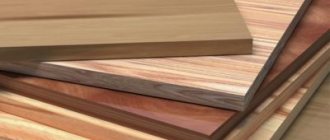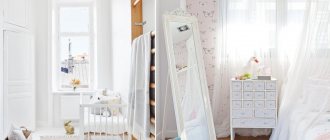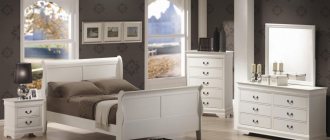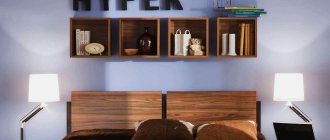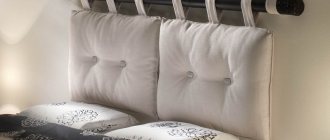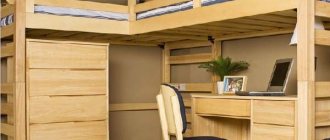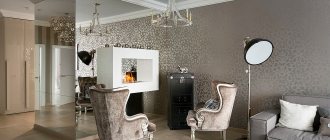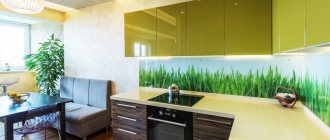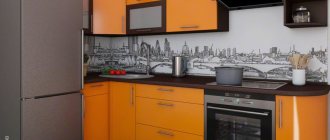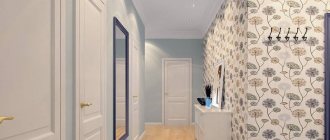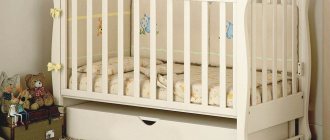Parents approach arranging a sleeping place for a child very responsibly, but in the process of choosing a bed they often reach a dead end. The most difficult question is deciding on the size of the bed. In this case, the following points are important:
- ➡ The size of the bed and the size of the sleeping place are different concepts;
- ➡ The bed must be suitable for the child in accordance with his physical characteristics;
- ➡ The bed should not “eat up” all the usable space in the children’s room;
- ➡ The current age of the child and the period during which the bed will be used are important.
Now let's look at these nuances in more detail.
Materials prohibited in the manufacture of children's furniture
The vast majority of children's furniture manufacturers use particle board (chipboard) as a material. This is a strong, durable and lightweight material. But chipboard has its own peculiarity - in the process of its production, formaldehyde resins are used, which can be harmful to human health. Depending on the level of formaldehyde resin content, the slabs are divided into classes: E1 and E2. Products of class E2 with a higher level of resin content are prohibited from being used for the production of children's furniture. Class E1 slabs are recognized as safer; all harmful components are minimized. The quality of the plywood used for visible surfaces must be not lower than grade I/Ill according to GOST 3916.1 and grade Ikh/Shkh according to GOST 3916.2 for invisible surfaces not lower than grade III/IV according to GOST 3916.1, with orta l llx/IVx according to GOST 3916.2, for surfaces intended for cladding - not lower than grade IV/IV according to GOST 3916.1 and grade IVx/IVx according to GOST 3916.2, taking into account the fact that holes from defects and fallen knots located on the outer layers of plywood are properly sealed in accordance with the requirements of GOST 3916.1 and GOST 3916.2 . 5.2.19. In a furniture product intended for children's use, more than two seals are not allowed on the front surfaces.
Dimensions of structures according to GOST
The dimensions of furniture in a kindergarten must comply with GOST standards. It is also important that the dimensions of the structures are suitable for the specific age group of children. Tables for children under 5 years old can be double or four-seater. For the classroom, products with drawers for notebooks and books, reminiscent of school desks, are installed.
Dimensions of children's wardrobes, main types of furniture
| Marking, furniture number (mm) | Child height (mm) | Height from floor to table top (mm) |
| 900 | 400 | |
| 1 | 1050 | 460 |
| 2 | 1200 | 520 |
| 3 | 1350 | 580 |
Chairs intended for eating are also divided into several categories. This classification does not apply to play furniture and transformers. The depth of the seat surface must be at least 100 mm.
| Furniture number(mm) | Child height (mm) | Chair height from floor to seat (mm) |
| 900 | 220 | |
| 1 | 1050 | 260 |
| 2 | 1200 | 300 |
| 3 | 1300 | 340 |
The recommended dimensions of cots for children in the nursery group are 1200 x 950 mm, for children 3–7 years old - 1400 x 300 mm. Products for children are equipped with protective sides, the height of the bed can be adjusted. The use of longer furniture is allowed if this does not contradict the sanitary and hygienic standards for placing children in a specific area.
Features of confirming the conformity of children's furniture products
Confirmation of the conformity of children's furniture is carried out on the basis of the requirements of TR CU 025/2012, which regulates the quality and safety of furniture products, taking into account standard conformity assessment schemes, which are approved by the decision of the CU Commission 04/07/2011 No. 621.
Compliance of furniture intended for children's use is ensured through strict compliance with the requirements of furniture technical regulations or the requirements included in the List of documents in the field of standardization, the implementation of which on a voluntary basis leads to compliance with the requirements of these technical regulations.
Methods of research (testing) of furniture products, basic rules for sampling, which are carried out in order to comply with the requirements of technical regulations and confirm (assess) the conformity of furniture products, are presented in the provisions of the standards that are included in the List of standards containing methods and rules for measurements and tests (research ) intended for the fulfillment and application of the requirements of TR CU 025/2012.
Confirmation form
For children's furniture intended for consumers under the age of three years, the following form of confirmation is used - certification. Based on the results of all studies and examinations, the applicant receives a certificate of conformity.
Certification has the right to be carried out by accredited certification bodies that are included in the Unified Register of Certification Bodies. Only an accredited testing center (or laboratory), also included in the unified register, has the right to conduct research on furniture products for certification.
Important criteria
So, let’s determine the most important parameters that furniture for children should meet:
- Natural and hypoallergenic materials;
- strength and reliability of structures, thoughtfulness of the shapes of elements, convenience of fittings;
- correspondence of parameters to the preferences, temperament and age of the child.
Let us immediately note that when we say “child,” we take into account the characteristics of not only one baby. If you have two or more children, you definitely need to take into account the interests of each, and age has almost no effect on this. Relatively speaking, even a one-year-old baby can already point his finger at the color of the furniture that he likes best.
Who can be an applicant for certification of furniture products?
The applicant in the case of certification, which is carried out for a series of products according to schemes 1 and 2, has the right to be only an individual entrepreneur officially registered in the territory of a country - a member of the Customs Union, or another legal entity that is: - a manufacturer of furniture products; - performer of the functions of a foreign manufacturer (if there is an official agreement with him), namely in terms of ensuring full compliance of the supplied goods with the requirements of TR CU 025/2012, as well as in terms of liability for non-compliance of these products.
If certification is carried out for a batch of products according to scheme 3 c, an individual entrepreneur or other legal entity is subject to all of the above requirements, but at the same time he can be: - a manufacturer; — supplier (seller); - performer of the functions of a foreign manufacturer (if there is an official agreement with him), namely in terms of ensuring full compliance of the supplied goods with the requirements of TR CU 025/2012, as well as in terms of liability for non-compliance of these products.
What documents will the applicant need to obtain certification of children's furniture?
To carry out certification of furniture intended for use by children aged 0 to 3 years, the applicant must provide the following package of documents to the certification body. 1. Title and registration documents of the applicant (copies of the registration certificate of an individual entrepreneur or legal entity, certificate of registration with the tax authorities). 2. Technical description for a group of similar furniture or for a specific product, which must contain the following information: name of the furniture product (or group of products); functional purpose and designation of products; description of the product design; general view drawings of the product indicating functional and overall dimensions. 3. All available test reports (research) of furniture products carried out by the manufacturer, accredited testing laboratories, or a person performing the functions of a foreign manufacturer. 4. Supply agreement (contract) and/or invoice (exclusively for scheme 3c). 5. When confirming the conformity of furniture products using scheme 2c, a certificate for the manufacturer’s quality management system will be required, in the case where this system applies to design and production, or only the production of goods.
As additional information, the certification body has the right to request: - existing certificates for products issued by foreign certification bodies (if any); - other official documents directly or indirectly confirming the safety and quality of furniture products (if any).
The correspondence of the functional dimensions of furniture products for children under three years of age depends on the height group
Varieties
There are several types of furniture for use in kindergarten. Each group has its own purpose. The design and appearance of the product depend on it.
Outdoor playroom
In the courtyard of the kindergarten, furniture intended for outdoor and role-playing games is installed. The main functions of the products: stimulating the development of the child, encouraging his activity in the fresh air. The most common varieties:
- slides;
- swing;
- carousels;
- crossbar with rings (device for gymnastic exercises);
- play huts (houses).
Basic requirements for products: resistance to external influences, structural strength, durability of paint and varnish coating. Metal parts of children's garden furniture are coated with an anti-corrosion compound. The dimensions of swings and slides must correspond to the weight of the children.
Swing
Gorki
Carousels
Crossbar with rings
Play huts
For indoor games
The standard set of play furniture for children includes several types of products. Their main purpose is to stimulate the baby to understand the world around him. All furniture used for games is durable and easy to repair.
| Furniture type | Color | Design | Requirements |
| Tables, chairs | Yellow, beige, sand | The most simple form and design | Stability, long service life |
| Shelves, corners where books, crafts, toys are placed | All shades of brown | Any, without sharp corners | Durable, suitable for child's height |
| Cabinets | Olive, light green, blue | Wardrobe of several compartments with hinged doors | Spaciousness, convenient internal organization |
| Modular designs (transformable furniture) | Any | Collapsible product made from several elements | Easy to repair, strong connection of parts |
| Equipment for role-playing games | Bright colors are preferred. You can choose green shades for a corner of nature | Original shapes, abundant decor | Attractiveness and clarity of purpose |
| Containers, racks for toys | Neutral options: white, gray, beige | Large monolithic products, clearly visible to a child | Hypoallergenic materials, easy to use by children without adult assistance |
Requirements for toy furniture, criteria for its correct selection.
In kindergartens, writing and drawing boards made like easels can be additionally used. Recommended color - any light, design - without decoration, rectangular or square shape. Basic requirements: strength and stability of the structure.
Tables, chairs
Shelves, corners
Cabinets
Modular designs
For role-playing games
Containers, racks
For the sleeping area
Furniture for the sleeping area is mainly beds. Recommended designs: classic, folding or retractable. It is strictly forbidden to install products consisting of two tiers - upper and lower. If a child care facility practices outdoor sleeping, cots can be used. Beds intended for a nursery group must have sides and fences. General requirements for furniture for the sleeping area: resistance to the use of detergents, strength of the base, durability.
Classic bed
Retractable
Folding
Dining room
In the area where children eat, tables for 4 people are used. Design options:
- monolithic, with a square or rectangular tabletop;
- folding;
- with adjustable height.
The main requirements for them: convenience, compliance with the growth of students. It is important that the products can withstand the weight of children belonging to a particular age group. The countertop must be resistant to high humidity and high temperatures. This applies to the material (wood, chipboard, fiberboard, furniture board) and paint coating. The child should be able to stand up and sit down independently during meals without difficulty.
The main requirements for children's dining tables: stability of the structure and strong fixation of the tabletop. The best manufacturing materials are wood or furniture board. Products with panels made of high-strength glass look beautiful, but they are not allowed to be used in kindergartens.
Monolithic table
Square
Rectangular
Folding
Height adjustable
Marking furniture for children
Furniture for children must be marked in such a way that it is preserved and remains legible throughout its entire service life. The following methods of marking are recommended: - on a fabric label or paper label; — marking can be applied by stamping, indelible paint, punching, burning, affixing individual details of the label with a special stamp; - it is allowed to apply color markings obtained by printing using a self-adhesive base; — it is allowed to apply markings to furniture packaging (for furniture supplied unassembled); — the tag/label should be firmly attached to the piece of furniture.
Regarding the location of marking, the following requirements exist: - a label/label is attached to each furniture product supplied assembled; — if the furniture will be supplied disassembled, a tag or label is placed in the packaging along with operational documents and assembly instructions, and is also applied to the packaging of such furniture.
Furniture labeling must include the following information: - name of the product by functional or operational purpose; — logo (trademark) of the manufacturer, if available; — product designation (model, proprietary, digital, etc.) — name of the country of origin; — location and name of the manufacturer; — name, actual and legal address of the person officially authorized by the manufacturer; - guarantee period; — date of manufacture; — service life established by the manufacturer; — EAC is a single mark for the circulation of products on the market of the member states of the Customs Union.
Furniture products intended for children that meet all safety requirements and have successfully passed the conformity assessment procedure must be marked with a single sign of product circulation on the market of the member states of the EAC Customs Union. Marking with this mark is carried out immediately before the release of any furniture product into circulation on the market. For example, on imported furniture the EAC mark must already be applied before the furniture products cross the border. According to the rules, the EAC Mark is applied directly to the label, which, in turn, is placed on the non-removable part of each individual product. In addition, the mark is also applied to accompanying documents (instructions, waybills) attached to furniture products.
The marking is applied in Russian and in another language of the CU member country, if required by the legislation of these countries.
Strength and reliability of structures, well-thought-out shapes of elements, convenience of fittings
If the materials used are safe, it is worth considering the design features of the furniture you choose. Let's not forget that any child is active. He will “test” the furniture, especially at the initial stage, from all sides. It must meet the highest requirements for strength and reliability. Parents, of course, want products to last as long as possible, so it doesn’t hurt to take durability into account.
Before choosing furniture, you should consider how it will be placed in the room. For example, for a desk you need to provide a place so that sunlight and artificial light fall on it from the left side. This is very important for the normal development of the child, of course, if your baby is right-handed.
Also be aware of sharp corners and protrusions. Often manufacturers of furniture for children's rooms take care of this, but engineers are not always able to think through everything 100%. In addition, each child has his own preferences. Relatively speaking, one will not crawl under the bed, but the other will definitely do it many, many times. Therefore, the shape of the furniture must be safe for the specific conditions of use. After all, the configuration and size of the room may be different, which means that not all models are suitable.
Also consider ergonomics. Often we do not have the opportunity to “waste” square meters by using them inefficiently. Therefore, think over the organization of the children's room and select the most suitable option for this “project”. Many manufacturers also provide entire sets of safe furniture for children's rooms. In this case, you won’t have to spend a long time assembling the elements, choosing a holistic solution from different components: a set, a bed, a table, and others.
And, of course, the fittings should not just look harmonious with the furniture. It must be practical, comfortable, placed in the right places. For example, if you choose a bunk bed, the steps to the second level should be safe, installed at a convenient distance from each other.
